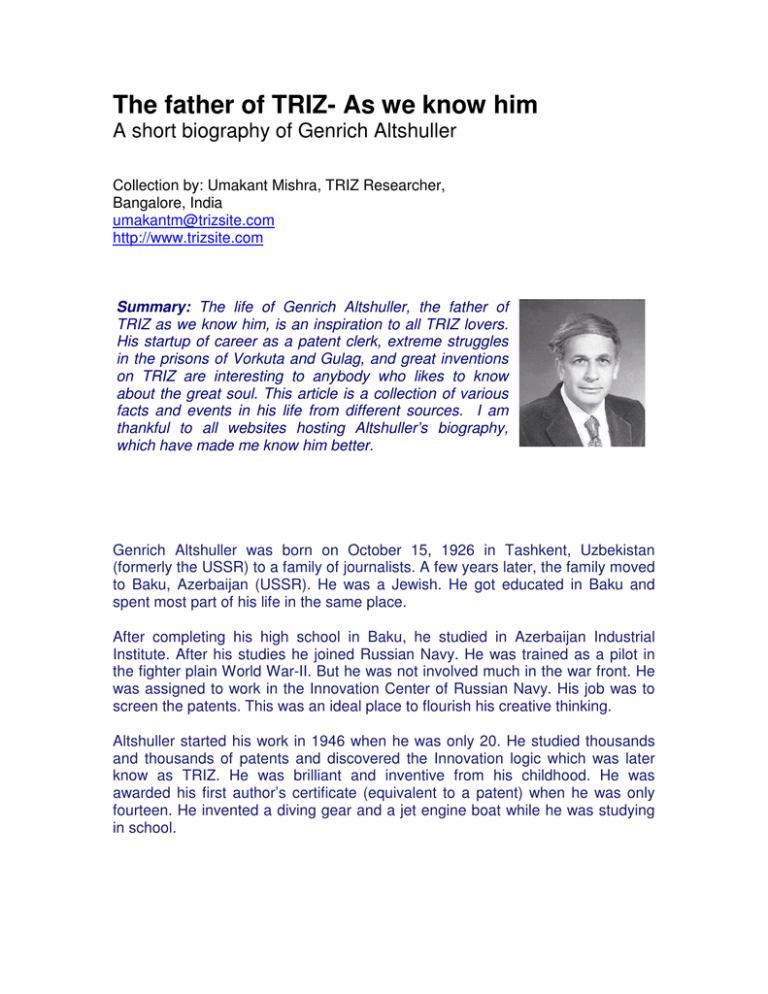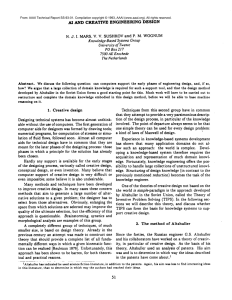The father of TRIZ- As we know him
advertisement

The father of TRIZ- As we know him A short biography of Genrich Altshuller Collection by: Umakant Mishra, TRIZ Researcher, Bangalore, India umakantm@trizsite.com http://www.trizsite.com Summary: The life of Genrich Altshuller, the father of TRIZ as we know him, is an inspiration to all TRIZ lovers. His startup of career as a patent clerk, extreme struggles in the prisons of Vorkuta and Gulag, and great inventions on TRIZ are interesting to anybody who likes to know about the great soul. This article is a collection of various facts and events in his life from different sources. I am thankful to all websites hosting Altshuller’s biography, which have made me know him better. Genrich Altshuller was born on October 15, 1926 in Tashkent, Uzbekistan (formerly the USSR) to a family of journalists. A few years later, the family moved to Baku, Azerbaijan (USSR). He was a Jewish. He got educated in Baku and spent most part of his life in the same place. After completing his high school in Baku, he studied in Azerbaijan Industrial Institute. After his studies he joined Russian Navy. He was trained as a pilot in the fighter plain World War-II. But he was not involved much in the war front. He was assigned to work in the Innovation Center of Russian Navy. His job was to screen the patents. This was an ideal place to flourish his creative thinking. Altshuller started his work in 1946 when he was only 20. He studied thousands and thousands of patents and discovered the Innovation logic which was later know as TRIZ. He was brilliant and inventive from his childhood. He was awarded his first author’s certificate (equivalent to a patent) when he was only fourteen. He invented a diving gear and a jet engine boat while he was studying in school. During 1946-48 he discovered the key techniques of TRIZ. He thought of utilizing TRIZ to recover the destructions took place during World War-II. Altshuller and his friend proposed some radical suggestions to the Rusian Government in 1948. But the result was negative, he was put into jail for long period. He had to stay in the labor camp in Vorkuta, in terrible cold above the Arctic Circle. He had to spend very difficult times in GULAG (the system of prisons in the USSR). Interestingly Altshuller was not the only elite in the prison, there were many other elites and academicians in the prison under the dictatorship of Stalin. They utilized this unique opportunity and taught many fields to each other, including mathematics, logic, science, foreign languages and many more. This knowledge helped Altshuller a lot to understand various systems from a generic perspective. After his inprisonment was over, Altshuller concentrated on writing stories and articles on science and fiction. His first article on TRIZ was published in 1956. His first story, Icarus and Dedalus, was published in 1957. He was writing under the pen-name Altov. He wrote many other books, such as “Ballad of the Stars”, “Donkey and Axiom” etc., which ware later, translated in many other languages. All his write-ups were full of brilliant and innovative ideas. Looking at the overwhelming response from the young generation, Altshuller wrote the book “And Suddenly the Inventor Appeared”, published in 1984. This was of course his best selling book. Altshuller’s major period of life was spent in studying patents. He screened over 200,000 patents to see how those problems were solved. He found that very few of them were real inventions. A majority are just straight forward improvements of the prior art. He discovered that all those inventions have used a certain set of rules to solve the problems. In other words, the same sets of rules have been applied over and over to solve all kinds of inventive problems. He listed out 40 such rules, called Inventive Principles, considered as the key technique of TRIZ. Instead of categorizing patents into the conventional classes of industry types, Altshuller categorized these patents into five different levels according to their novelty of invention. They are, 1. Routine design problems (solved by knowledge within the speciality), 2. Minor Improvements to an existing system (using knowledge within the industry), 3. Major / Fundamental Improvements to an existing system (using knowledge within and outside the industry), 4. New Inventions (using knowledge on the technology), 5. Rare discoveries (using knowledge of science and beyond). 99% of the patents fell into the first 4 categories, only less than 1% were found to be discoveries. Altshuller differentiated between a general problem and an Inventive problem. He defined an inventive problem is one in which the solution causes another problem to appear. For example, “Increasing the strength of a metal plate, causes its weight to be heavier”. We need strength of the plate but not its weight. Traditionally inventors have compromised between strength (improving feature) and weight (worsening feature) and resorted to some trade-off, such that the plate is neither too thick nor too weak. But these solutions do not yield the maximum desired result (Ideal result), as the plate was neither too strong nor too light. An inventive solution does not compromise, rather eliminates the contradiction, i.e., increases the benefits of improving feature (strength) and reduces the effects of worsening feature (weight). Altshuller not only wrote articles and books, he also organized several workshops and seminars on TRIZ. Some workshops were continuing quite long (for several weeks) like intensive training programs. In 1971, he founded the “Public Institute for Inventive Creativity”, which was the first TRIZ institute of the world. He helped to organize local TRIZ schools through his students and TRIZ enthusiasts. There were over 500 such TRIZ schools all over the former USSR. He wrote about 20 books and about 400 articles related to TRIZ. He took about 65 seminars and taught over thousands of students. He was an author of several patents. Altshuller believed that a healthy society needs more creative individuals. The creative individuals pursue efforts towards noble goals. Without these individuals, the problem of human society will become acute and lead towards destruction. In philosophical terms he was a great rationalist and believed the power of reasoning could solve all problems. TRIZ is the method of his rational approach to strong thinking and problem solving. In 1989, Altshuler became the President of the “International TRIZ Association”, founded by his friends and students. In 1990, he and his family moved to Petrozavodsk, Russia, where he lived till the end of his life. His presence in Petrozavodsk made the place a center of TRIZ research and association. The great soul passed away on September 24, 1998, due to complications from Parkinson’s disease. Altshuller’s wife Valentina Zhuravleva was alive till 2004. She was a co-author to him for many books on science and fiction. Altshuller left a revolutionary science behind him, the Theory of Inventive Problem Solving (TRIZ), which will keep him alive in the memory of thousands of people all over the world. His great discoveries and contribution to the mankind will keep him immortal for all time to come. Key Information Full name Pen name Born Wife Settled in Worked as Died Genrich Saulovich Altshuller Genrikh Altov On October 15, 1926, in Tashkent, USSR Valentina Zhuravleva. Major period in Baku (Azerbaijan), later period of life in Petrozavodsk after Soviet breakup. Journalist, essayist and a writer on science and fiction. September 24, 1998 Reference: 1. “An unmythical Altshuller”: by Leonid Filkovsky, Baltimore, USA, http://www3.sympatico.ca/karasik/LF_part1.html 2. “Genrich Altshuller”, http://www.wikipedia.org 3. Altshuller’s Biography http://www.altshuller.ru/biography From in Wikipedia, Altshuller the free foundation’s encyclopedia web site,







